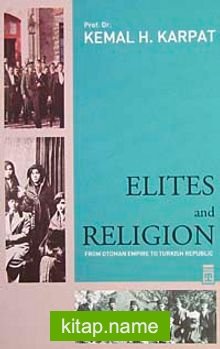Kategori:
Tarih
Yazar:
Prof. Dr. Kemal H. Karpat
Yayınevi:
Timaş Yayınları
Elites And Religion
Tanıtım Bülteni
Professor Karpat, one of the most prominent names in the field of Political History, explores the social structure of Ottoman Empire through different eras and looks at Turkey’s multi-party democracy culture from a historical perspective. His articles interpret the Ottoman history for broader audience and lay a vivid picture of events of recent history in front of our eyes.Professor Karpat’s remarkable articles take us back to 18th century Ottoman days and examine change and modernization on those days, his work also looks into the independence and interaction of various social groups within a muslim state. The Ottoman social structure produced a unique way of practicing “secularism” where spiritual issues regarding faith and administrative issues regarding everyday state politics were kept completely independent from each other; one was dealing with earthly matters of day to day life of subjects of the Ottoman sultan, the other was to aid the followers of specific faith in their practice of religion and to prepare for after-life.Ottomans, despite having a highly complex social structure accommodating a number of ethnic groups and various religious orders, had successfully sustained freedom of faith by adopting the ‘millet’ system. Every non-muslim community represented by its leader was regarded as a ‘millet’ and enjoyed an absolute autonomy and freedom within its own faith and community in terms of practice of religion, language, social relations.During the Tanzimat era a new generation of religious leaders; who were relatively free from state regulations emerged among Ulema and unlike their predecessors they were not dignitaries. The social status of this newly emerging group from within well- established Ulema which was preoccupied at times to legitimise social and political change from an Islamic perspective or at other times tried to maintain status-quo siding with government, overlapped with the social image of the Ottoman middle-class. The fact that the new generation Ulema had common characteristics with ordinary middle-class people had a profound impact on Ottoman-Turkish political history. Consequently, the road map of ‘modernity and secularism’ set in Republican Turkey was identified by both the state represented by military and civilian bureaucrats and by people represented by local notables.


Kitap Yorumları - (5 Yorum)
türkiye modernleşmesi çalışanlat için temel kaynaklardan biri
Modernleşme okurlarının okuması gereken bir eser.
Türkçe adı elitler ve din olan bu kitapta elitler, din, laiklik ve modernleşme üzerinde durulmuş.
çok detaylı bilgiye ulasmak isteyenler mutlaka Kemal Karpatı okumalı.tarafsızlıgı da önemli bir etken.
Although the title implies specific focus on the elites and religion, the book does not limit itself to the aforementioned areas. It is about the changing social dynamics in general within the Ottoman population and how it is transferred to the newly found Rebuplic. You can read through to see how social group formation and economic power constructed Ottoman elites and how the story of these groups, starting from 19th century, flows into contemporary Turkish politics.
Benzer Kitaplar
Kırşehir Türbeleri Bozkırın Sessiz Tanıkları
Moğollarda Ceza ve İşkence (Büyük Moğol İmparatorluğu ve İlhanlılar )
Osmanlı’da Hac Kültürünün Dolaşımında Hac el Yazmaları Nebzetü’l-Menaşık Mekke Medine Kudüs
Anadolulu Tanrı Apollon’un İzinde
Sadıkbey Yalıların Dili Olsa
Orhan Bey
Uzun Hasan ve Otlukbeli Savaşı
Ortaçağ İslam Dünyasında Asayiş
Türkiye Selçuklu Devleti Tarihi
Germenlerle Slavların Kökeni Avrupa’daki Türk Boylarının Dönüşümü
Millî Mücadele 1921
Geçmişten Günümüze Doğum, Evlenme ve Ölümde Kütahya
Antik Çağ Mutfak Kültürü
Irak Şiîliği (Arap-Fars Şiîliği Bağlamında) Tarihî, Sosyo-Politik Analiz
Sapiens: Grafik Tarih 2 Uygarlığın Sütunları